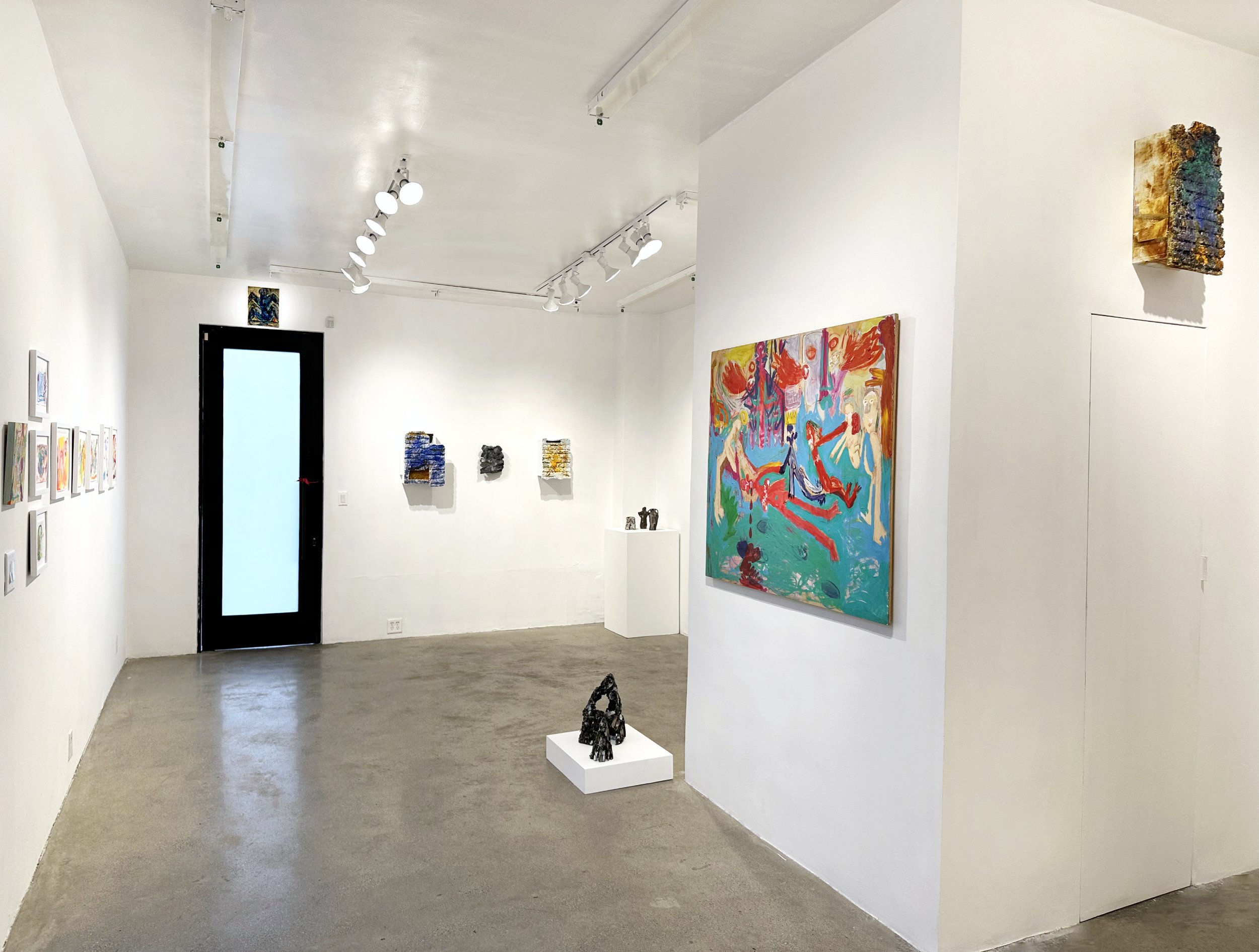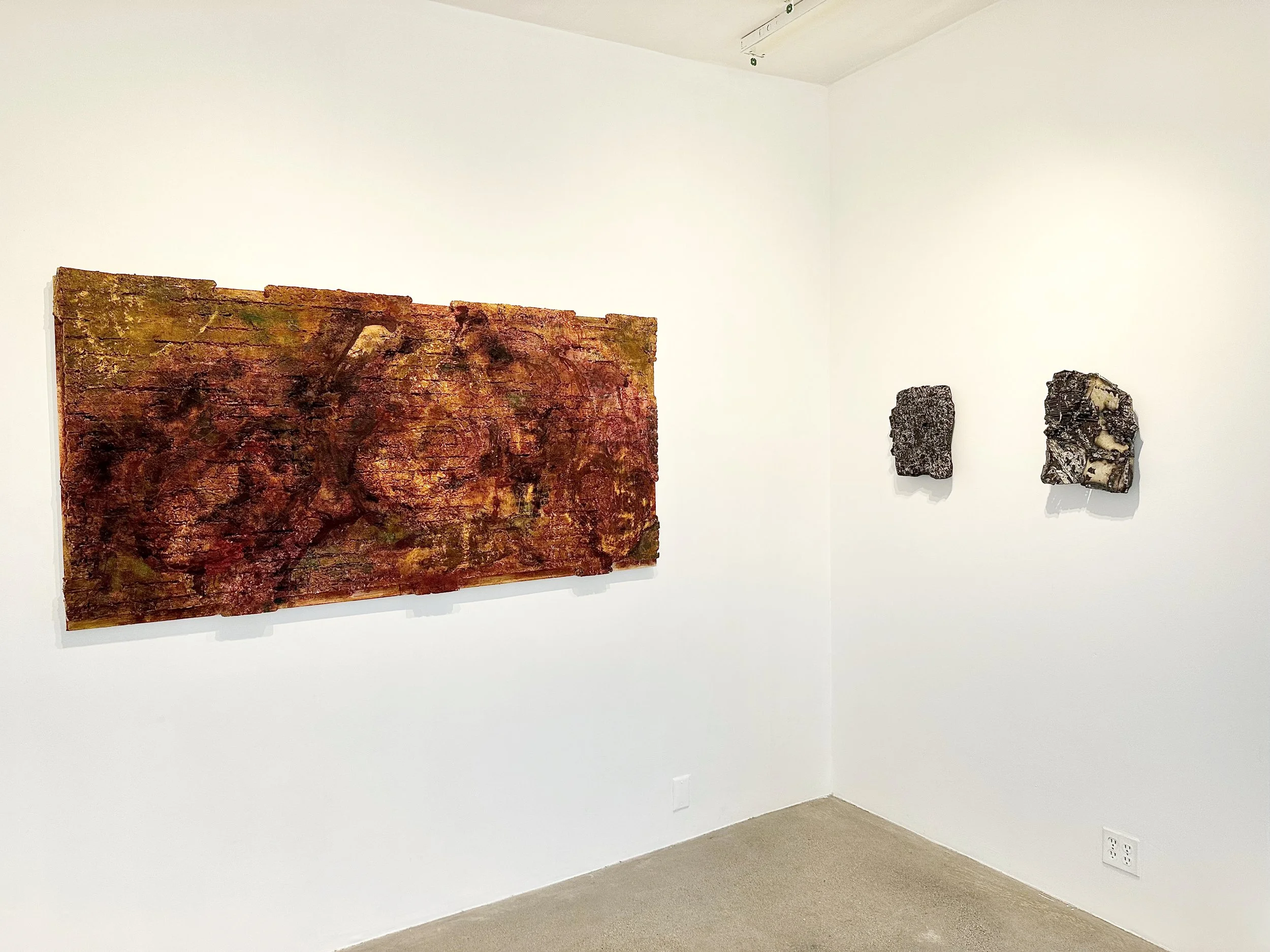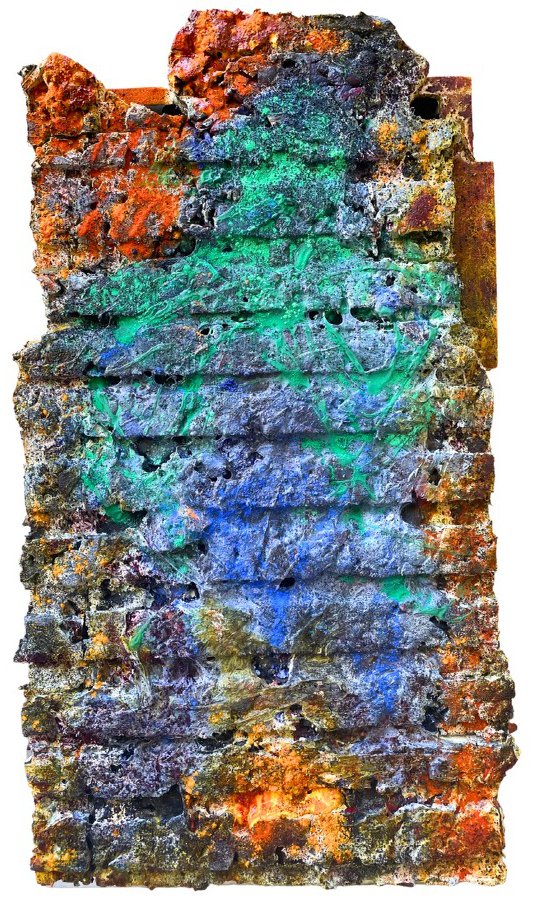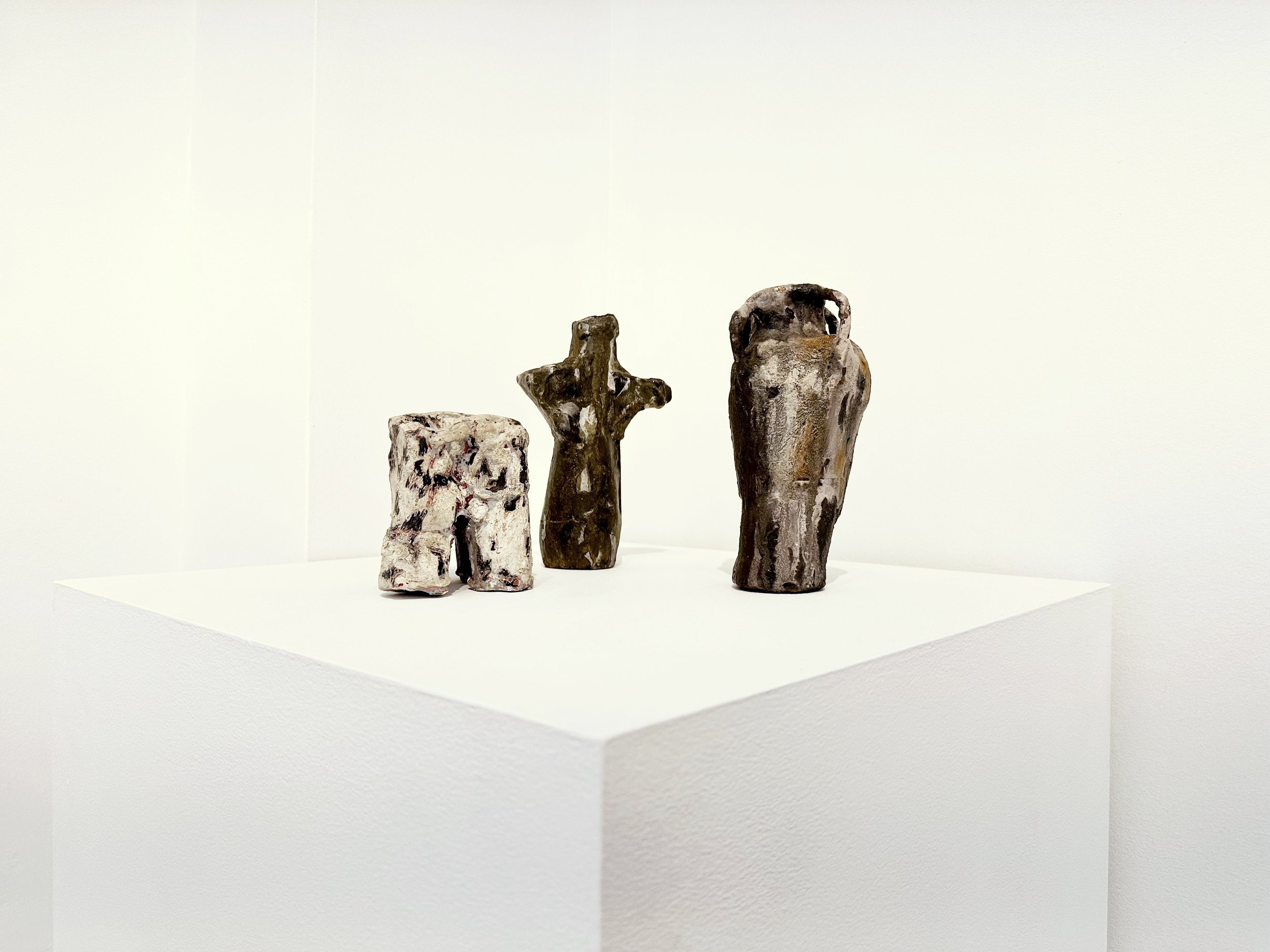Skins, Holes, and Hovels. Ari Salka, Erica Everage, Kento Saisho. October 14 - November 11, 2023. Group Exhibition.
Installation View [10/18/2023]: Oriented at front of Gallery, facing Northwest.
shut
Skins, Holes, and Hovels
Ari Salka, Erica Everage, Kento Saisho
Duration: October 14 - November 11, 2023.
Location: 2680 South La Cienega Blvd, Los Angeles, CA 90034.
Type: Group Exhibition
Press: This Week’s Must-See Art (Curate LA: October 12-October 18, 2023).
Documentation: Checklists (Group; Salka; Everage; Saisho)
Topology: Diagram
Recordings: Exhibition Video.
….
Contact the gallery via email:
gallery@reisigandtaylorcontemporary.com
____
____
Reisig and Taylor Contemporary is presenting a group exhibition of figural and abstract works by three Los Angeles-based artists: Ari Salka, Erica Everage, and Kento Saisho. Drifting between bright and dark, waking and dreaming, the exhibition includes expressively diaristic mixed-media drawings/paintings by Salka, sculpturally and materially driven mixed-technique works by Everage, and multi-dimensional fabricated and forged steel sculptures by Saisho. Although each artist inhabits distinct materials and processes, all of their practices uniquely meld techniques of drawing, painting, sculpting, and writing. Discretely but collectively, the works personally confront the limits of a body through trans, feminine, and queer practices that question and transform the (normalized) symbolic and material dimensions of an artwork.
Mark by unmark, a shared archaeological language recurs between layered abstractions of bodies, vessels, voids, imprints, and echoes—between carnal presences and absences. Between skins, holes, and hovels.
….
A sealed vessel that gushes, filled with draining. A drawing that tears-up, sobbing. A painting that speaks in tongues, licking itself dry. A tooth to sit on. And even a place to hide your honey hole…. Sometimes more forgotten, sometimes more remembered (more personal), the shifting works track primal traits of figure, mark, flesh, and structure through mysterious deconstructions of glitchy iconographies and slipping materialities. Altered, altared. Each work is radically aware of its own body, and of its position within a system of endlessly oscillating oppositions. Repeatedly marked, filled, or drained, these bodies appear as vessels—but as leaky, shivering, cracked vessels. Determined as much by what they leak or lack as what they hold. Is this body filling-up or being-drained? Ambiguously sacred and cursed, ravished by supernatural charm. Is this a body that floats, or a body that drowns? With a change of state at each blink of a gaze, the objects dissolve any observation with their gushing. Shattered and assembled by their pouring.
Insides outs, and outsides in. Dorsals, ventrals, and back again.
Following this dysmorphic movement through sequenced transformations and portaled structures (as thresholds of change), the exhibition winds a symbolic (rite of) passage from the delirious to the lucid and back again. But with each cycle some residue of a reality is left exposed to the viewer as their encounters with the works circulate throughout social, (art) historical, and political determinations of materiality, gender, sexuality, and subjectivity. (An Oedipal struggle with the odor always already left lingering in a room.) Estranged, yet still populated by the mythologies in which they emerge, the works keep track of the rituals and bodies they contact. It is at this point of repeated contact with others where the exhibition touches symptoms of power structures present in interactions with objects and images—and their cathexes. Specifically, power is confronted as a shape of desire, a libidinal order. The works subtly and overtly disrupt dominant distinctions of taste or aesthetic desire, personally regenerating a pleasure principle through trans, feminist, and queer modes of embodiment. However, this communal critical consciousness seems as much a material result as a conceptual strain of the artists’ processes and their collective focus on how to record gesture, meaning, expression, and memory occurring at different times in the same place. Posed as a question: how is one body recorded on the surface of another? Or, how is an encounter between bodies recorded by an object?
With Salka’s diaristic approach to their hybrid drawings-paintings, a response to these questions plays out in the relations between expression, figuration, memory, and mark-making. Their poetically titled, small-scale drawings included in the exhibition, many of which display autobiographical fragments of a body marked by transitions and recoveries, find a synchrony between gestural marks and expressive distortions through the process of giving an account of themselves. (A sequenced transformation, recorded.) More, the deep temporal range between the pieces themselves reiterates the transitional sequence on their timestamped bodies. Written in shards, these notational accounts arrive shattered but bound by a (w)hole. And with the perforated edgings of the paper often left intact, a disconnected continuity—the rimming of a lack, hole, or cut—is also performed on the level of the piece of paper itself: the surface of the depicted figures, and the surface of the object itself, arrive in the same instant of -piction. This tension between act, imprint, and surface is sustained across each of their works in the exhibition, but the recorded history becomes more painterly layered and figurally populated when they move from notebook paper to larger-scale canvas or panel. Playfully traumatic, each layer, and each mark, remembers a moment of contact between Salka against some instance of their skin.
Similarly process-driven around marks (and therefore interested in how a transformative sequence is recorded), but more so oriented by specific materials, Everage works between color, texture, and structure while evolving ancient or abandoned imagery in contemporary forms. Folding the past into the present, she refinds blurry connections between history and memory, with attention to perennial—though perhaps forgotten—symbols that epigenetically determine relations between gendered modes of embodiment and (recognizable) categories of identity. In particular, many of the figures from which she works in abstraction are feminine Western deities or idol-types—such as the Sheela na gig—placed along pathways or above doors (or any portal-like structure): guardians of a hole marking a hovel. At the same time, her use of interstitial materials, such as burlap and artificial turf sub-base, suggests that this engagement with voids per voided, discarded, or in-between substances begins on the level of the substrates of her work. Confronting patriarchal notions of openings or holes as mere absence (of the phallus), she works with a void as a surface or object in itself, and not necessarily as an emptiness.
As a sculptor and metal worker, Saisho perhaps works most directly with material transformations—in this case, metals—and the shaping of voids through the production of vessels in varying phases, textures, and dimensions. His works demonstrate a vessel’s peculiar simultaneity of presence and absence, filling and draining, skin and hole (and hovel): covers and leaks. One of his works included in the exhibition, Four Legged Object, displays these paradoxical synchronicities through a dreamlike object that seems to remember a tooth, a stool, a cake—a vessel. Refusing any single association, the weird object is tangled-up in the cob webs between a domestic space and a body’s interior traits. This soporific slippage between objects, images, memories, and identities recurs across the objects. But there are also slippages between mediums. Among his newest works, wall-mounted vessels more loosely assembled than this previous works, there is a layering of gesture, fragment, and mark that similarly occurs in works by Salka and Everage through a kind of drawing. Gathered in populations, guiding viewers’ movements around the room, Saisho’s sculptures triangulate and mediate each encounter with an image or object produced by the other artists. At times the void is sealed, at times the void is open—and at times the void is scattered and diffuse: each phase of his work provides a slipping glimpse of a body changing states while sheltering its lacks. With their yawns, clasps, gapes, and growls, Saisho brings the glyphic shapes of the vessels to the brink of speech—without ever saying anything at all.
Tracing metamorphic drives of un/making, marking, and recording along these varying but intertwined paths, the exhibition ultimately gathers around a question of lost parts and how they are either recovered, contained, or transformed. Like a bite mark that traces its void, the exhibition asks how to capture what is missing in what is present. But a bite mark may be read even if it won’t say a word. Toothy indentations betray the mouth’s absence. Emptied of itself but nonetheless present. Or full of itself but nonetheless absent. This undecidability and ambiguity structures the silent language writing between the works. This language does not necessarily consist of words. (Or the words only appear once I wake from the work’s dream.) It is made of scars, chants, and howls. Without letters but still written, this language operates on a primal narcissism—a primordial crossing or exchange—that ceaselessly splits object, image, material, and identity along the seams of a body come undone, un/covered. Along stains, sutures, and shelters. Along skins, holes, and hovels.
Like looking down a clogged drain the works suspend their gravity, gasping for a breech.
After all, it was always just drainage for angels.[i]
….
Ari Salka (b. 1993 in Seattle, WA) is an LA-based artist who primarily works through writing, painting, and drawing. Salka holds a BFA from the School of the Art Institute of Chicago (2016) and MFA in Painting from UCLA (2019). In addition, Salka studied at the Yale Norfolk Summer School of Art and received the Ellen Battell Stoeckel Fellowship in Norfolk, CT (2015). Their most recent solo exhibition was with Lauren Powell Projects (Los Angeles). In November, they are invited to be a visiting artist as part of Bennington College’s visiting artist lecture series.
Erica Everage (b. 1987, Los Angeles, CA) is an L.A.-based visual artist. She won a Los Angeles Music Center Spotlight Award in 2005 for her drawing, which earned her an apprenticeship with the late sculptor Robert Graham, who taught her to sculpt. Erica has a BA in Theatre from Northwestern University and an MFA in Fine Art from Otis College of Art and Design. Her passions for history, feminism, storytelling, and dance all inform her current work as a painter. Some of the most recent presentations of her work include a solo exhibition titled In Her Image at Hotel Figueroa in Los Angeles (on view through February 2024), as well as a group exhibition with The Cooler x Reclaim in Fresno, CA.
Kento Saisho (he/him) is an artist and metalworker currently based in Los Angeles, CA. He makes vigorously textured and tactile sculptural objects, vessels, and contemporary artifacts in steel that utilize and push the material’s potential for transformation. Born and raised in Salinas, CA, he graduated from the Rhode Island School of Design (RISD) in 2016, where he was a Windgate-Lamar Fellowship recipient from the Center for Craft in Asheville, NC. Following this, he completed the Core Fellowship at the Penland School of Craft from 2018-2020. He was also a recipient of the inaugural Emerging Artist Cohort from the American Craft Council (ACC) in 2021 and the 2022 Career Advancement Grant from the Center for Craft. He has exhibited nationally and internationally and is currently represented by Citron Gallery in Asheville, NC.
__
{Biographical information courtesy of the artists.}
___________
[i] Artaud, Antonin. Artaud le Mômo (1946-8). “Et ce fut toujours vidange pour ange,” (“And it was always drainage for angels,”).
Installation View [10/18/2023]: Oriented at front of Gallery, facing Northwest.
Installation View (10/25/23)\Evening: Facing West toward central column.
Installation View (10/25/23)\Evening: Facing South entrance from gallery rear.
Kento Saisho. Untitled (Mound). 2023. Steel, paint, patina, mixed media. 12 x 14 x 14 inches.
Kento Saisho. Stack. 2023. Steel, paint, graphite, patina. 5 in x 5 in x 8 in.
Installation View (10/18/23)\Day: Facing Northwest nook in front section of gallery. Left works by Erica Everage. Right works by Kento Saisho.
Erica Everage. Ggantija (Hidden Architecture). 2023. Dye, Raw pigments, acrylic, mortar paste, spackle, shellac on reclaimed foam matting mounted on wood panel. 37 x 72 x 2.75 inches.
Erica Everage. Ggantija (Hidden Architecture). 2023. Dye, Raw pigments, acrylic, mortar paste, spackle, shellac on reclaimed foam matting mounted on wood panel. 37 x 72 x 2.75 inches. [Detail.]
Installation View (10/18/23)\Day: Facing South Wall of central pillar of gallery. Works by Kento Saisho.
Kento Saisho. Tablet. 2022. Steel, paint, graphite, patina. 10.5 x 2 x 14 inches.
Kento Saisho. Untitled (Tablet). 2023. Steel, paint, patina. 12 x 14 x 2 inches.
Installation View (10/18/23)\Day: East Wall.
Ari Salka. Green Hands, Blue Clouds. 2018. Mixed Media on Paper. 8.5 in x 5.5 in (framed 11 in x 9 in).
Ari Salka. Nostalgia Has A Way Of Sealing A Loss We Did Not Know We Were Losing. 2022. Acrylic, Latex Paint, Resin, Gesso, Watercolor, Raw Pigment, China Marker and Oil on Wood. 8 x 10 inches.
Ari Salka. Nostalgia Has A Way Of Sealing A Loss We Did Not Know We Were Losing. 2022. Acrylic, Latex Paint, Resin, Gesso, Watercolor, Raw Pigment, China Marker and Oil on Wood. 8 x 10 inches. [Detail.]
Ari Salka. Distant Waters. 2018. Mixed Media on Paper. 5.5 x 8.5 inches (11 x 9 inches framed).
Ari Salka. Hands, Do I Miss You Or Do I Miss Me? 2019. Ink, Acrylic, Pastel, and Oil Pastel on Paper. 5.5 x 8.5 inches (11 x 9 inches framed).
Ari Salka. When The Body Opens, And The Pill. 2018. Mixed Media on Paper. 5.5 x 8.5 inches (11 x 9 inches framed).
Installation View (10/18/23)\Day: East Wall. Works by Ari Salka.
Ari Salka. The House and the Heart. 2018-2019. Mixed-Media on Paper. 9.75 x 12 inches (12 x 15 inches framed).
Ari Salka. The Pills As Eyes: The Green Angel, The Purple Ghost And The Yellow Woman. 2018. Watercolor, Ink, Pastel, and Acrylic on Paper. 9.75 x 12 inches (12 x 15 inches framed).
Ari Salka. Hands Can't Reach Far Enough Now. 2018-2020. Mixed-Media on Paper. 9 x 12 inches (12 x 15 inches framed).
Ari Salka. Flowers and a Chair. 2018-2023. Mixed Media on Paper. 12 x 9 inches (15 x 12 inches framed).
Ari Salka. The Narrator Is Not Always Clear. 2021. Ink, Acrylic, Oil, Pencil, and Pastel on Paper. 12 x 9 inches (15 x 12 inches framed).
Installation View (10/18/23)\Day: Facing Northwest Corner.
Ari Salka. Lamentations, 2017. Acrylic, Gesso, Chalk Pastel Ink, and Latex Paint on Wood. 41 x 48 inches.
Ari Salka. Lamentations, 2017. Acrylic, Gesso, Chalk Pastel Ink, and Latex Paint on Wood. 41 x 48 inches.
Installation View (10/25/23)\Evening: Facing North Wall.
Ari Salka. Hands, They Do Often Reach Out. 2022. Acrylic, Enamel China Marker, Gesso, India Ink, Resin, and Latex Paint on Wood. 96 x 20 inches. [Day.]
Ari Salka. Hands, They Do Often Reach Out. 2022. Acrylic, Enamel China Marker, Gesso, India Ink, Resin, and Latex Paint on Wood. 96 x 20 inches. [Evening.]
Installation View (10/25/23)\Evening: Looking Northwest at sculptures by Saisho.
Kento Saisho. Mound. 2022. Steel, patina, paint. 11 x 6 x 14 inches.
Kento Saisho. Mound 2. 2022. Steel, paint, patina. 12 x 14 x 14 inches.
Kento Saisho. Object in Steel 5. 2022. Steel, paint, patina. 16 x 5 x 12 inches.
Installation View (10/18/23)\Day: Facing West wall in rear gallery enclave. Works by Erica Everage.
Erica Everage. Goddess with Her Consort (diptych: left). 2023. Goddess with Her Consort (diptych: right). 2023. Dye, raw pigment and acrylic on burlap. 14 x 22 inches (14 x 11 inches each).
Erica Everage. Apotropaic Display. 2023. Watercolor, dye and raw pigment on burlap. 16 x 20 inches.
Erica Everage. Lounging Megalith. 2023. Raw pigment, chalk pastel and wax on burlap. 9 x 12 inches.
Erica Everage. Glyph. 2023. Acrylic and raw pigment on burlap. 12 x 9 inches.
Installation View (10/18/23)\Day: Diagonally facing West wall in rear gallery enclave. Surfaces by Erica Everage. Sculpture by Kento Saisho.
Kento Saisho. Untitled (stone-like object). 2023. Steel, paint, graphite, patina. 3 x 11 x 2 inches.
Kento Saisho. Untitled (stone-like object). 2023. Steel, paint, graphite, patina. 3 x 11 x 2 inches.
Kento Saisho. Conjoined Vessel. 2023. Steel, paint, graphite. 6 x 11.25 x 4 inches.
Kento Saisho. Conjoined Vessel. 2023. Steel, paint, graphite. 6 x 11.25 x 4 inches.
Installation View (10/18/23)\Day: Facing East wall in rear gallery enclave. Works on sides by Kento Saisho. Central work by Erica Everage.
Kento Saisho. Circular Tablet. 2023. Steel, paint, patina. 12 x 16 x 2 inches.
Erica Everage. Mini Shadow Dancer. 2023. Raw, natual pigment and watercolor on burlap. 14 x 11 inches.
Kento Saisho. Untitled (platter). 2023. Steel, paint, patina, graphite. 4 x 8 x 16 inches.
Installation View (10/25/23)\Evening: Facing south entrance from gallery rear (behind sculptures by Saisho).
Erica Everage. Sheela Ablaze. 2023. Acrylic & raw pigment on reclaimed foam composite matting mounted on wooden box frame. 19.5 x 11 x 6 inches.
Erica Everage. Sheela Ablaze. 2023. Acrylic & raw pigment on reclaimed foam composite matting mounted on wooden box frame. 19.5 x 11 x 6 inches.
Erica Everage. Sheela Ablaze. 2023. Acrylic & raw pigment on reclaimed foam composite matting mounted on wooden box frame. 19.5 x 11 x 6 inches.
Erica Everage. Sheela Motif. 2023. Raw, natural pigment and wax on burlap. 12 x 9 inches.
Installation View (10/18/23)\Day: Facing Southwest corner of gallery.
Installation View (10/18/23)\Day: South wall of gallery. Works on Side by Erica Everage. Central work by Kento Saisho.
Erica Everage. Mining. 2023. Acrylic, wax, coral resin and raw pigment on reclaimed foam mat and acetate mounted on wood frame. 19 x 13.5 x 6.5 inches.
Erica Everage. Mining. 2023. Acrylic, wax, coral resin and raw pigment on reclaimed foam mat and acetate mounted on wood frame. 19 x 13.5 x 6.5 inches.
Kento Saisho. Untitled (Tablet 2). 2023. Steel, paint, patina, graphite. 9 x 10 x 2.5 inches.
Erica Everage. Sheela in the Wall. 2023. Acrylic and raw pigment on reclaimed foam mat mounted on wood frame. 14.25 x 11 x 5.75 inches.
Installation View (10/18/23)\Day: Facing plinth positioned in Southwest corner of front of gallery.
Kento Saisho. Four Legged Object. 2021. Steel, paint, graphite, patina. 4 x 4 x 5 inches.
Kento Saisho. Four Legged Object. 2021. Steel, paint, graphite, patina. 4 x 4 x 5 inches. [Detail.]
Kento Saisho. Two Handed Vessel. 2021. Steel, paint, patina. 5 in x 2 in x 8 in.
Kento Saisho. Four Handled Vessel. 2021. Steel, paint, patina. 4 x 8 x 4 inches.
Installation View (10/18/23)\Day: Facing West toward central column from outside French doors on patio.
Kento Saisho. Forged Vessel 2. 2018. Steel, patina. 9 x 10 x 7 inches.
Kento Saisho. Forged Vessel. 2018. Steel, patina. 6 x 13 x 8 inches.
Installation View (10/18/23): Facing outer east gallery wall in patio area. Vessels by Kento Saisho. Wall sculpture by Erica Everage.
Installation View\Day: Facing outer east gallery wall in patio area. Vessels by Kento Saisho. Wall sculpture by Erica Everage. [Alternative Placement.]
Installation View\Night: Facing outer east gallery wall in patio area. Vessels by Kento Saisho. Wall sculpture by Erica Everage.
Erica Everage. Puzzling Quarry. 2023. Raw pigments, acrylic, wax and copal resin on reclaimed foam matting mounted on wood. 31 x 21 x 2.75 inches.
Erica Everage. Puzzling Quarry. 2023. Raw pigments, acrylic, wax and copal resin on reclaimed foam matting mounted on wood. 31 x 21 x 2.75 inches. [Alternative View.]
Erica Everage. Puzzling Quarry. 2023. Raw pigments, acrylic, wax and copal resin on reclaimed foam matting mounted on wood. 31 x 21 x 2.75 inches. [Detail.]
![Installation View [10/18/2023]: Oriented at front of Gallery, facing Northwest.](https://images.squarespace-cdn.com/content/v1/619c221f6addfe04124c8b97/c4741129-603a-4176-a182-5b2cb020b85e/IMG_9462.jpg)







![Erica Everage. Ggantija (Hidden Architecture). 2023. Dye, Raw pigments, acrylic, mortar paste, spackle, shellac on reclaimed foam matting mounted on wood panel. 37 x 72 x 2.75 inches. [Detail.]](https://images.squarespace-cdn.com/content/v1/619c221f6addfe04124c8b97/0cc76e3d-948d-472a-83e6-1304ee0a29e2/IMG_9337.jpg)







![Ari Salka. Nostalgia Has A Way Of Sealing A Loss We Did Not Know We Were Losing. 2022. Acrylic, Latex Paint, Resin, Gesso, Watercolor, Raw Pigment, China Marker and Oil on Wood. 8 x 10 inches. [Detail.]](https://images.squarespace-cdn.com/content/v1/619c221f6addfe04124c8b97/570339d9-1ef3-4e46-9214-6d31be880c63/IMG_9340.jpg)













![Ari Salka. Hands, They Do Often Reach Out. 2022. Acrylic, Enamel China Marker, Gesso, India Ink, Resin, and Latex Paint on Wood. 96 x 20 inches. [Day.]](https://images.squarespace-cdn.com/content/v1/619c221f6addfe04124c8b97/647b0443-4f14-48d2-93b7-642f0cbf594a/IMG_9485.jpg)

![Ari Salka. Hands, They Do Often Reach Out. 2022. Acrylic, Enamel China Marker, Gesso, India Ink, Resin, and Latex Paint on Wood. 96 x 20 inches. [Evening.]](https://images.squarespace-cdn.com/content/v1/619c221f6addfe04124c8b97/e6357659-f89a-4160-b1f6-55d68019696b/Hands+They+Often+Do+Reach+Out-+Salka_.jpg)
































![Kento Saisho. Four Legged Object. 2021. Steel, paint, graphite, patina. 4 x 4 x 5 inches. [Detail.]](https://images.squarespace-cdn.com/content/v1/619c221f6addfe04124c8b97/11c28063-54c4-4890-b6a3-cfac8caae6fa/IMG_9512.jpg)








![Installation View\Day: Facing outer east gallery wall in patio area. Vessels by Kento Saisho. Wall sculpture by Erica Everage. [Alternative Placement.]](https://images.squarespace-cdn.com/content/v1/619c221f6addfe04124c8b97/6c33ba92-d6cb-4e71-914a-3da244b83697/IMG_9503.jpg)


![Erica Everage. Puzzling Quarry. 2023. Raw pigments, acrylic, wax and copal resin on reclaimed foam matting mounted on wood. 31 x 21 x 2.75 inches. [Alternative View.]](https://images.squarespace-cdn.com/content/v1/619c221f6addfe04124c8b97/1fd093e8-d3af-4d39-b1b1-29245c386860/Puzzling+Quarry_Everage.jpeg)
![Erica Everage. Puzzling Quarry. 2023. Raw pigments, acrylic, wax and copal resin on reclaimed foam matting mounted on wood. 31 x 21 x 2.75 inches. [Detail.]](https://images.squarespace-cdn.com/content/v1/619c221f6addfe04124c8b97/4cba958d-ed88-4f41-a058-96e51e5371d4/IMG_9509.jpg)
